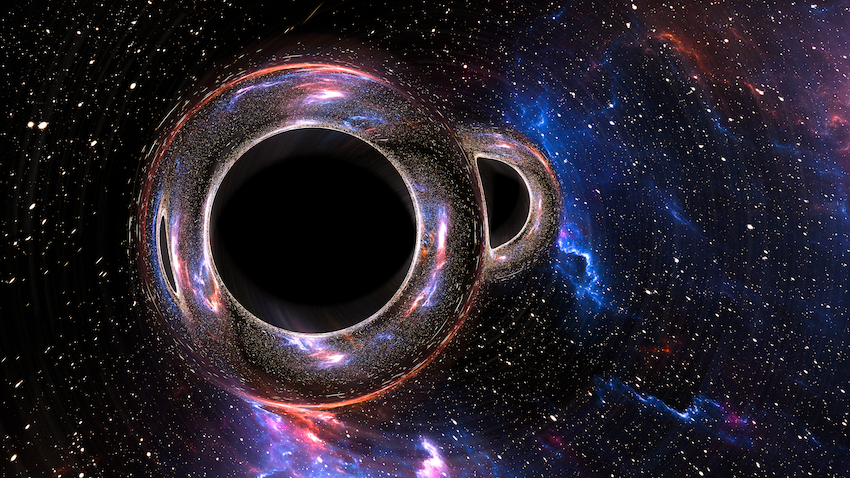A pair of very special black hole mergers, detected just one month apart in late 2024, add an important new piece to our understanding of the most violent phenomena in our universe. Some features of these mergers point toward the possibility of “second-generation” black holes, i.e. black holes that are the result of earlier coalescences, probably formed in very dense and crowded cosmic environments, like star clusters, where black holes are more likely to run into each other and merge again and again.
In a new paper published today, 28 October 2025, in The Astrophysical Journal Letters, the International LIGO-Virgo-KAGRA Collaboration announced the detection of two gravitational-wave signals that occurred in October and November of last year and that exhibit features never observed before. Gravitational waves are “ripples” in spacetime that originate from deep-space cataclysms: the most intense signals of this kind are often generated by the collision of black holes. By using extremely sophisticated algorithms and mathematical models, it is possible to reconstruct from the analysis of these signals many of the physical characteristics of the black holes that generated them: their mass, the distance from the Earth, and even the speed and direction of their rotation around their own axis, called spin. The new detection concerns gravitational waves produced by the merger of black holes that, in particular, display unusual spins, that is, peculiar rotational characteristics. This observation therefore adds a new and important piece to our understanding of the most elusive phenomena in the universe.
The first merger detected, GW241011 (11 October 2024), occurred about 700 million light-years from the Earth and was caused by the collision of two black holes with masses of about 17 and 7 times that of our Sun. The larger of the two black holes in GW241011 is one of the fastest-spinning black holes observed so far. Almost a month later, on 10 November 2024, GW241110 was detected, a signal coming from about 2.4 billion light-years from the Earth, produced by the merger of black holes with masses of about 16 and 8 times that of our Sun. While most of the black holes observed rotate in the same direction as their orbit, the primary black hole of GW241110 rotates in the opposite direction and represents the first case of this kind ever observed.
“Each new detection provides important clues about the universe, because every observed merger is both an astrophysical discovery and an exceptional laboratory for probing the fundamental laws of physics”, emphasised Carl-Johan Haster, co-author of the study and professor of astrophysics at the University of Nevada, Las Vegas, United States. “Binaries like these had been predicted, but this is the first direct evidence of their existence”.
Both detections also indicate the possibility of ‘second-generation’ black holes.
“GW241011 and GW241110 are among the newest events among the several hundred that the LIGO-Virgo-KAGRA network has observed”, explained Stephen Fairhurst, coordinator of the LIGO scientific collaboration and professor at Cardiff University, United Kingdom. “Both events have one black hole significantly more massive than the other and rapidly rotating, and they provide compelling evidence that these black holes formed from previous black hole mergers”.
Some of the clues that guided the scientists of the collaborations concern the difference in size between the black holes in each merger (the larger was almost twice as massive as the smaller) and the orientation of the rotation of the larger black holes in each event. A natural explanation for these peculiarities is that the black holes are the result of previous mergers. This process, called hierarchical merging, suggests that these systems formed in dense environments, in regions such as stellar clusters, where black holes are more likely to collide and merge repeatedly.
“These detections highlight the extraordinary capabilities of our global gravitational-wave observatories”, emphasised Gianluca Gemme, coordinator of the Virgo scientific collaboration and researcher at INFN, the Italian National Institute for Nuclear Physics. “The unusual spin configurations observed in GW241011 and GW241110 not only challenge our understanding of black hole formation but also provide compelling evidence of hierarchical mergers in dense cosmic environments: they teach us that some black holes do not exist only as isolated partners but probably as members of a dense and dynamic population. These discoveries underline how important global collaboration is in order to detect and unveil the most elusive phenomena in the universe”.
Discovering the hidden properties of black hole mergers
The precision with which GW241011 was measured made it possible to test under extreme conditions some of the key predictions of Albert Einstein’s theory of general relativity. In fact, this event can be compared with theoretical predictions and with the solution proposed by mathematician Roy Kerr for rotating black holes. The rapid rotation of the black hole slightly deforms it, leaving a characteristic imprint on the gravitational waves it emits. By analysing GW241011, the research team found excellent agreement with the Kerr solution and once again verified Einstein’s prediction, with unprecedented precision. Moreover, since the masses of the individual black holes differ significantly, the gravitational-wave signal contains the “hum” of a higher harmonic, similar to the harmonics of musical instruments, observed only for the third time in GW241011. One of these harmonics was observed with extreme clarity and confirms another prediction of Einstein’s theory.
“This discovery also means that we are more sensitive than ever to any new physics that may go beyond Einstein’s theory”, said Haster.
In search of elementary particles
Rapidly spinning black holes like those observed in this study also represent a source of new knowledge for particle physics. Scientists can use them to test the existence of certain light elementary particles and to infer their mass. These particles, called ultralight bosons, are predicted by some theories that go beyond the Standard Model of particle physics, which describes and classifies all known elementary particles and their interactions. If ultralight bosons exist, they can extract rotational energy from black holes: how much energy is extracted and how much the rotation of the black holes slows over time depends on the unknown mass of these particles. The observation that the massive black hole in the binary system that emitted GW241011 continues to rotate rapidly even millions or billions of years after its formation rules out a wide range of ultralight boson masses.
“The detection and study of these two events demonstrate how important it is to make our detectors work in synergy and to strive to improve their sensitivity”, explained Francesco Pannarale, co-chair of the Observational Science Division of the LIGO-Virgo-KAGRA Collaborations and professor at Sapienza University of Rome. “Our instruments have once again taught us something about how black hole binaries form and about the fundamental physics that governs them. With the upgrade of our interferometers, we will be able to explore these and other aspects further thanks to the greater precision of our measurements”.






